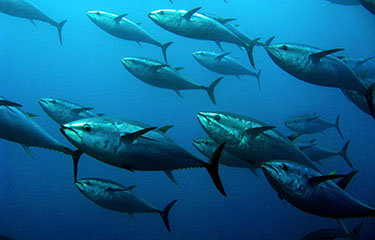Global consensus is building around the viability of harvest strategies for fisheries management, according to The Ocean Foundation International Fisheries Conservation Project Director Shana Miller.
Harvest strategies, also known as management procedures, are pre-agreed frameworks for making fisheries management decisions based on a proactive approach designed to achieve long-term sustainability for the fishery. According to an Ocean Foundation primer, harvest strategies include management objectives that set a vision for each fishery; a monitoring program to collect data; indicators of the fishery’s status and population health; a method to assess those indicators; and harvest control rules (HCRs) that set fishing opportunities, which could include catch limits and size limits.
“If designed correctly, harvest strategies benefit both the fish and fishermen,” The Ocean Foundation said. “Recognizing the effectiveness of these tools, many international fisheries management bodies are developing or implementing strategies appropriate for their fisheries.”
In fact, four of the five major tuna regional fisheries management organizations (RFMOs) developed or otherwise committed to harvest strategies in 2022 – only the Inter-American Tropical Tuna Commission (IATTC) has yet to commit. Miller said that puts them on the path to ensuring better stock sustainability and health.
“A harvest strategy is synonymous with a management procedure,” Miller said. “A harvest control rule – HCR – is the operational part of a harvest strategy. The HCR sets fishing opportunities based on some indicator of stock status. The harvest strategy is a combination of the HCR, plus management objectives, a data-collection method, and a method for evaluating stock status based on those monitoring data. The purpose of management strategy evaluation [testing] is to simulate the fisheries system and then pick a harvest strategy that will perform well against your management objectives, regardless of which future scenario is true.”
In 2022, harvest strategies were adopted by the International Commission for the Conservation of Atlantic Tunas (ICCAT) for Atlantic bluefin tuna, by the Indian Ocean Tuna Commission (IOTC) for bigeye tuna, and by the Western and Central Pacific Fisheries Commission (WCPFC) for skipjack tuna in the western and central Pacific. Miller said she was particularly impressed by the implementation of a harvest strategy for Atlantic bluefin.
“Atlantic bluefin tuna is not a high-volume fishery, but it's a billion-dollar fishery. People have been fishing bluefin tuna in the Mediterranean for thousands of years. It's part of their culture. So, anything with bluefin tuna in the Atlantic is controversial,” Miller said. “In 2017, ICCAT hired an independent management strategy evaluation [MSE] expert to build MSE models of the mixed stock fishery. The MSE uses data on the movements and mixing of those two different populations to evaluate impacts of catch on both sides of the Atlantic on the separate populations. So, that's very complex, and it's the first time stock-mixing has been accounted for in Atlantic bluefin tuna management. The new management procedure sets the catch limit for this year and the next two years. After that, the same rule will be used to set the catch limit for the next three years.”
Miller said she harvest strategies for up to eight additional fisheries – including tuna, swordfish, and forage fish – could potentially be adopted in the near future, including the WCPFC and IATTC considering the adoption of harvest strategies for North Pacific albacore and Western Atlantic skipjack in 2023.
“As fisheries and RFMO managers become more familiar with the process and the science advances, the RFMOs are following through on the harvest strategy development commitments that they made several years ago,” Miller said. “The first seven tuna harvest strategies have taken a decade to secure, but in 2023 alone, we could get an additional five.”
For Global Tuna Alliance Executive Director Tom Pickerell, it shouldn’t just be NGOs pushing for the adoption of harvest strategies, but seafood business as well.
“From a supply-chain perspective, they are very beneficial. In the first instance, they can maintain populations and fisheries at their targets – which provides consistency and security. Sound harvest strategies increase transparency and predictability of fisheries management, which promotes industry stability. They also improve market access; some sustainable seafood certification programs, including the Marine Stewardship Council, require that fisheries have harvest strategies in place and some companies are now requiring (or plan to require) source fisheries have them in place,” Pickerell told SeafoodSource.
Pickerell is heading a campaign, in coordination with The Ocean Foundation, to urge seafood suppliers to contact RFMOs to urge further adoption of harvest strategies. But he warned harvest strategies must come with mechanisms for insuring compliance to be effective.
“A good example here is Indian Ocean skipjack. This stock has an HCR, but the HCR-associated TAC [total allowable catch] has been exceeded by up to 30 percent in every year since adoption. The TAC was increased by almost 10 percent to 513,572 tons for the 2021-2023 period,” he said. “This is putting the MSC certifications at risk – as well as ignoring the HCR.”
Pickerell said assignment of national opportunities to participate in the fishery via quota allocations are necessary to ensure HCRs are followed.
“At present, in many tuna fisheries, there is no allocation mechanism employed,” he said. “Most tuna RFMOs rely on historical catch or effort. Annual negotiations are instead used, and these are akin to horse-trading, often driven by special interests.”
Miller called out the IOTC for failing to properly implement a harvest strategy for skipjack, and said she’s hoping it doesn’t repeat the mistake with bieye.
“The way the process should work is to adopt the harvest strategy, including allocation of the fishing opportunities, and then implement the harvest strategy,” Miller said. “Unlike IOTC’s handling of skipjack, the bigeye catch limit calculated for 2024 by the newly adopted harvest strategy is slated to be allocated and endorsed this year. Therefore, we hope the skipjack problem of overcatches will not be repeated.”
In November 2022, The Ocean Foundation’s International Fisheries Conservation Program and partnered with the United Nations Food and Agriculture Organization (FAO) to launch HarvestStrategies.org in order to educate stakeholders about harvest strategies. The tool is multilingual in English, Spanish, and French, and includes resources in 13 other languages, and a decision-analysis tool called Slick that allows users to see outcomes of candidate harvest strategies while accounting for uncertainty.
”HarvestStrategies.org is the culmination of years of collaboration among governments, fishers, scientists and civil society to demystify the inner workings of this innovative and effective approach to ensuring a prolific future for tuna and other valuable fisheries,” Miller said. “This site will be a go-to resource for fisheries participants and professionals of all backgrounds and expertise.”
Photo courtesy of Guido Montaldo/Shutterstock







